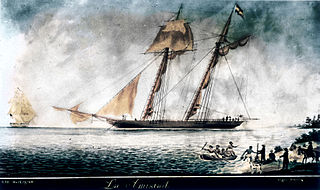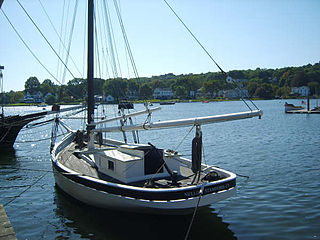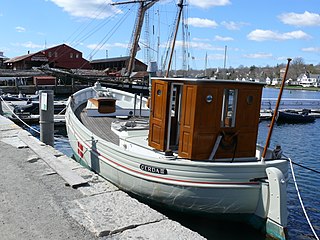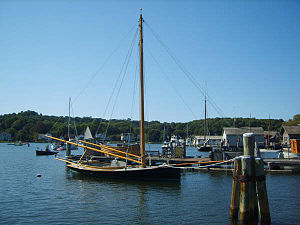
Mystic is a village and census-designated place (CDP) in Groton and Stonington, Connecticut.

Mystic Seaport Museum or Mystic Seaport: The Museum of America and the Sea in Mystic, Connecticut is the largest maritime museum in the United States. It is notable for its collection of sailing ships and boats and for the re-creation of the crafts and fabric of an entire 19th-century seaport village. It consists of more than 60 historic buildings, most of them rare commercial structures moved to the 19-acre (0.077 km2) site and meticulously restored.

Joseph Conrad is an iron-hulled sailing ship, originally launched as Georg Stage in 1882 and used to train sailors in Denmark. After sailing around the world as a private yacht in 1934 she served as a training ship in the United States, and is now a museum ship at Mystic Seaport in Connecticut.

Charles W. Morgan is an American whaling ship built in 1841 that was active during the 19th and early 20th centuries. Ships of this type were used to harvest the blubber of whales for whale oil which was commonly used in lamps. Charles W. Morgan has served as a museum ship since the 1940s and is now an exhibit at the Mystic Seaport museum in Mystic, Connecticut. She is the world's oldest surviving (non-wrecked) merchant vessel, the only surviving wooden whaling ship from the 19th century American merchant fleet, and second to USS Constitution, the oldest seaworthy vessel in the world. Charles W. Morgan was designated a National Historic Landmark in 1966.
Commodore Charles W. Morgan was an officer in the United States Navy during the War of 1812.

The Mystic River is a 3.4-mile-long (5.5 km) estuary in the southeast corner of the U.S. state of Connecticut. Its main tributary is Whitford Brook. It empties into Fishers Island Sound, dividing the village of Mystic, Connecticut between the towns of Groton and Stonington. Much of the river is tidal. The Mystic River was the location of three large shipbuilding firms during the 19th-century, and it is now the home of the Mystic Seaport maritime museum. The name Mystic is derived from the Pequot term "missi-tuk", describing a large river whose waters are driven into waves by tides or wind, according to the Mystic River Historical Society.

La Amistad was a 19th-century two-masted schooner owned by a Spaniard living in Cuba. It became renowned in July 1839 for a slave revolt by Mende captives who had been captured and sold to European slave traders and illegally transported by a Portuguese ship from West Africa to Cuba, in violation of European treaties against the Atlantic slave trade. Spanish plantation owners Don José Ruiz and Don Pedro Montes bought 53 captives in Havana, Cuba, including four children, and were transporting them on the ship to their plantations near Puerto Príncipe. The revolt began after the schooner's cook jokingly told the slaves that they were to be "killed, salted, and cooked." Sengbe Pieh unshackled himself and the others on the third day and started the revolt. They took control of the ship, killing the captain and the cook. Three Africans were also killed in the melee.

L. A. Dunton is a National Historic Landmark fishing schooner and museum exhibit located at the Mystic Seaport Museum in Mystic, Connecticut. Built in 1921, she is one of three remaining vessels afloat of this type, which was once the most common sail-powered fishing vessel sailing from New England ports. In service in New England waters until the 1930s and Newfoundland into the 1950s. After a brief period as a cargo ship, she was acquired by the museum and restored to her original condition.

Sabino is a small wooden, coal-fired steamboat built in 1908 and located at the Mystic Seaport Museum in Mystic, Connecticut. It is one of only two surviving members of the American mosquito fleet, and it was declared a National Historic Landmark in 1992. It is America's oldest regularly operating coal-powered steamboat.

Emma C. Berry is a fishing sloop located at the Mystic Seaport Museum in Mystic, Connecticut, United States, and one of the oldest surviving commercial vessels in America. She is the last known surviving American well smack. This type of boat is also termed a sloop smack or Noank smack. The Noank design was imitated in other regions of the United States.

Mystic Ballet is a modern dance company based in Mystic, Connecticut, founded in 1997 by Goran Subotic.

Australia was a coasting schooner located at Mystic Seaport in Mystic, Connecticut, United States. Australia was built in 1862 in Great South Bay, Long Island, New York and was originally named Alma. Australia was designed to carry freight and to be able to traverse shallow water. Australia was used as a Confederate blockade runner during the American Civil War until she was captured by Union warships and sold at auction. Mystic Seaport acquired her in 1951 for use as a training vessel. In 1962 Australia was hauled out for restoration but damage to the hull was deemed too extensive and the vessel was permanently beached. Australia was housed in a shed and used as an exhibit on ship construction, until she was scrapped in the late 2010s. The building is now being used for another purpose.

Florence is a western rig dragger located at Mystic Seaport in Mystic, Connecticut, United States. Florence was built in 1926 by Franklin G. Post along the Mystic River and was used as a dragger in Long Island Sound. In 1982 Florence was acquired by Mystic Seaport and completely restored to her original configuration. Florence is the only working dragger in a museum collection. Florence is now used to carry students to collect marine biology specimens from Fishers Island Sound.

Nellie is an oyster sloop located at Mystic Seaport in Mystic, Connecticut, United States. Nellie was built in 1891 in Smithtown, New York and was used for oyster dredging in Long Island Sound. Mystic Seaport acquired her in 1964 to add to their collection of watercraft.

Gerda III is a lighthouse tender located at Mystic Seaport in Mystic, Connecticut, United States. Gerda III was built in 1928 in Denmark and was used as a common work boat. In 1943 Gerda III was used by 19-year old Henny Sinding to smuggle Jews from Nazi occupied Denmark to Sweden. Approximately 300 Jews were rescued by Gerda III. The Danish Parliament donated Gerda III to The Museum of Jewish Heritage in New York City. Mystic Seaport now cares for the vessel and features her as part of their collection of watercraft. The rescue story is the subject of the 1991 film A Day in October.

Brilliant is a schooner located at Mystic Seaport in Mystic, Connecticut, United States. Brilliant was built in 1932 on City Island, Bronx, by Henry B. Nevins Yard to a design by Olin Stephens of Sparkman & Stephens for Walter Barnum. Brilliant was built as an ocean racing yacht, and on her maiden voyage crossed the Atlantic Ocean in just over 15 days, 1 hour and 23 minutes, a record for a sailing yacht of her size. Brilliant ran from Nantucket Lightship to Bishop Rock Light, England.

Roann is an Eastern rig dragger located at Mystic Seaport in Mystic, Connecticut, United States. Roann was built in 1947 in Thomaston, Maine by Newbert & Wallace and was used to fish for flounder, cod, and haddock. Mystic Seaport acquired the vessel to add to their collection of watercraft after she became obsolete in the 1970s. In 2009, Roann underwent a complete restoration.
Walton, a three-masted barque, was built for the Parker family in Walton, Nova Scotia in 1855. Under the command of Frederick Parker, brother of ground-breaking Halifax/Dartmouth doctor Daniel McNeill Parker, Walton was painted by notable marine artist Michele Renault in 1857 off Livorno (Leghorn), Italy. The painting currently hangs in a private home in Dartmouth, Nova Scotia. In speaking of his uncle, Captain Frederick, family historian William Frederick Parker notes: "His voyages took him chiefly to the Indian and China seas and the Mediterranean, in the barque 'Walton.' He too, lost his life in following his profession. He was never married. His body was interred at Cardiff, Wales. ".
The Tempest 23 is an American trailerable sailboat designed in 1962 by Philip Rhodes and Richard D. Carlson.
















